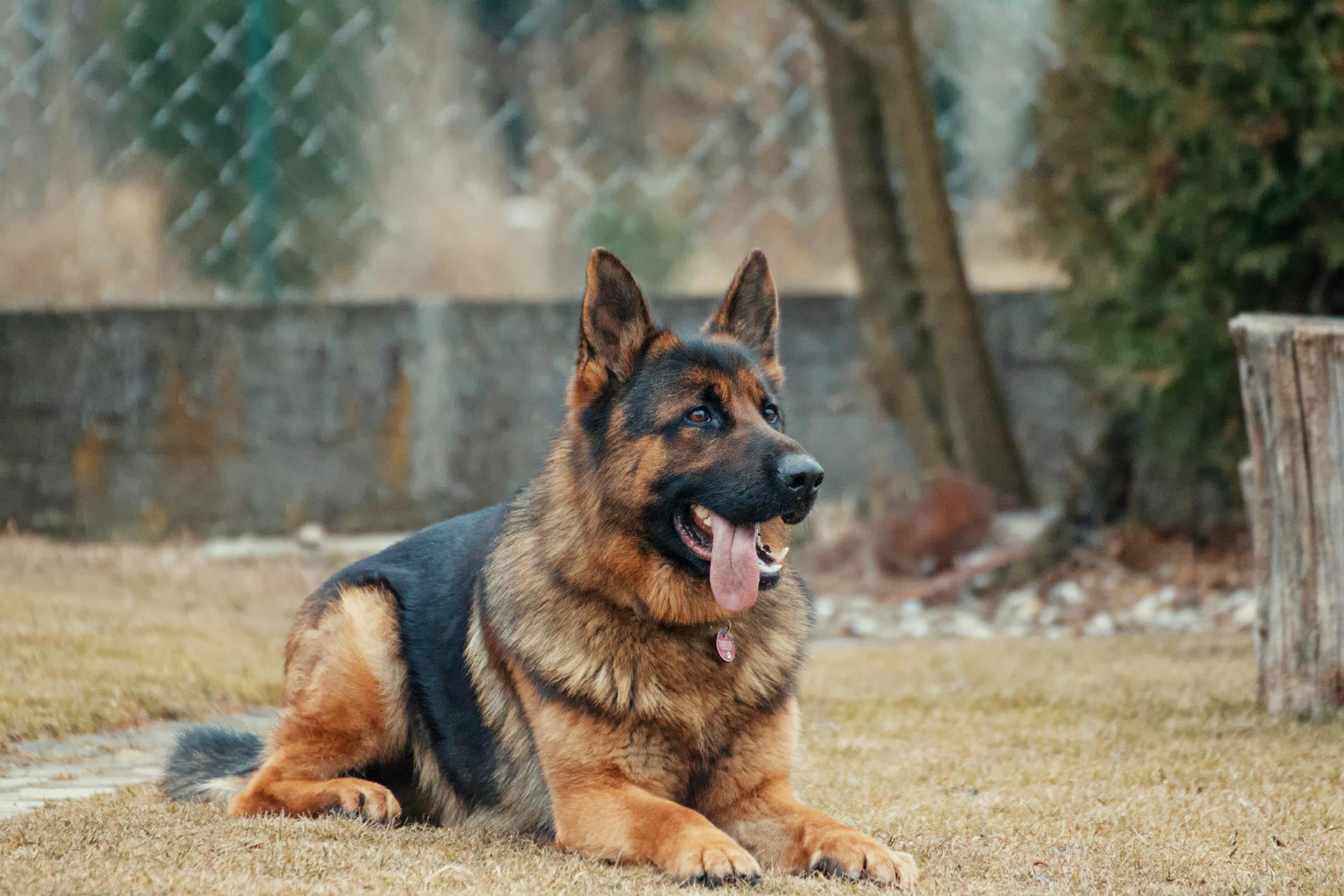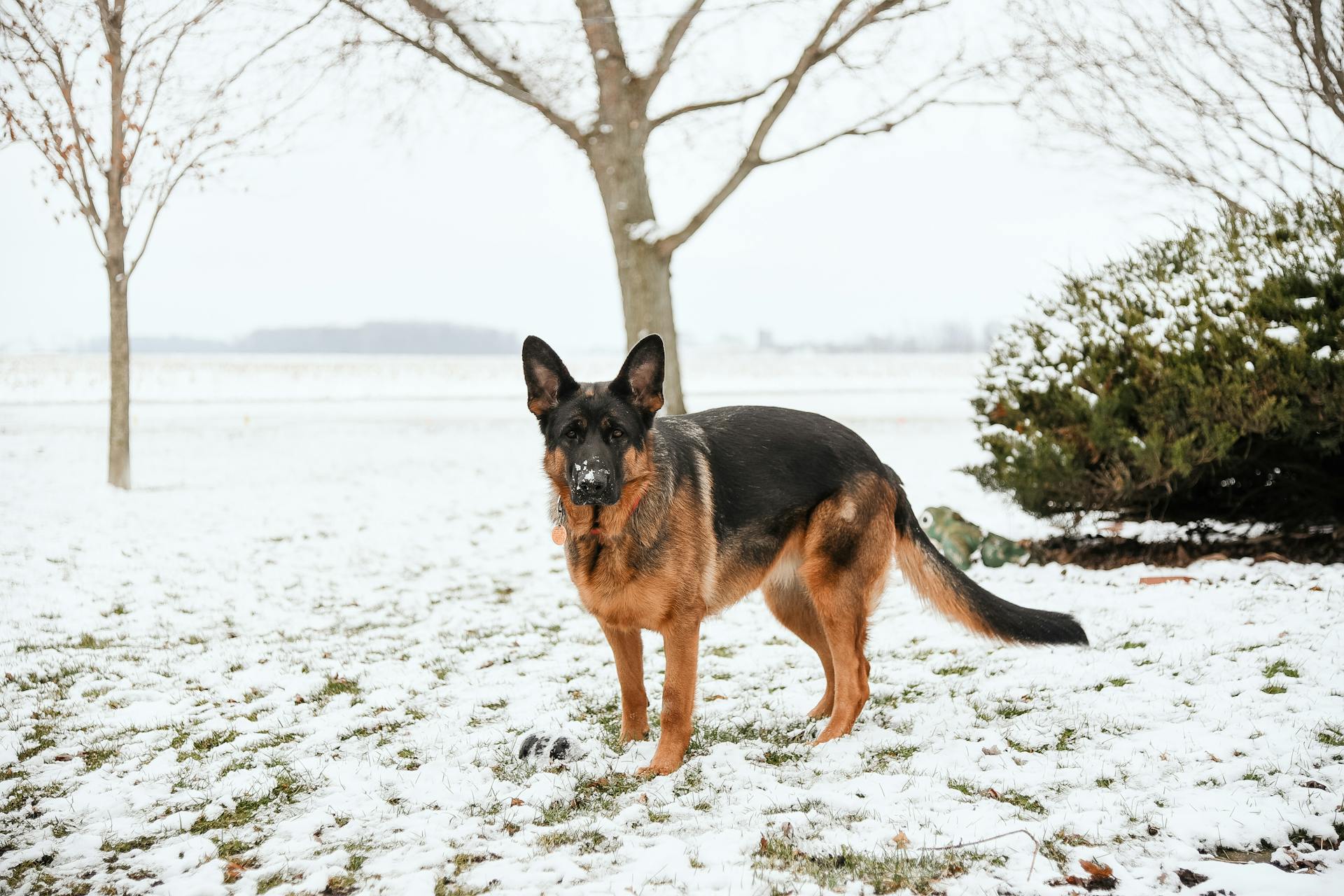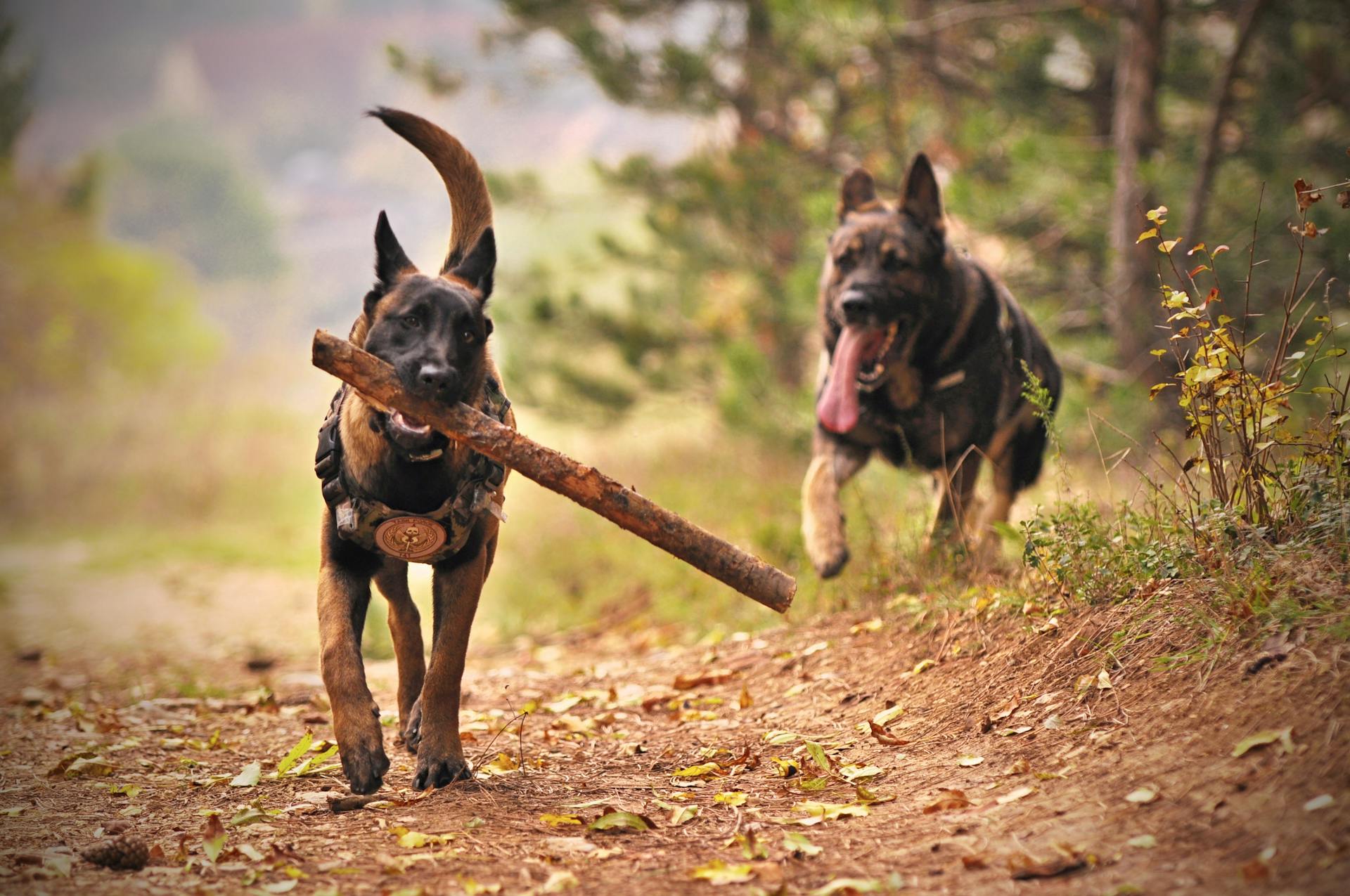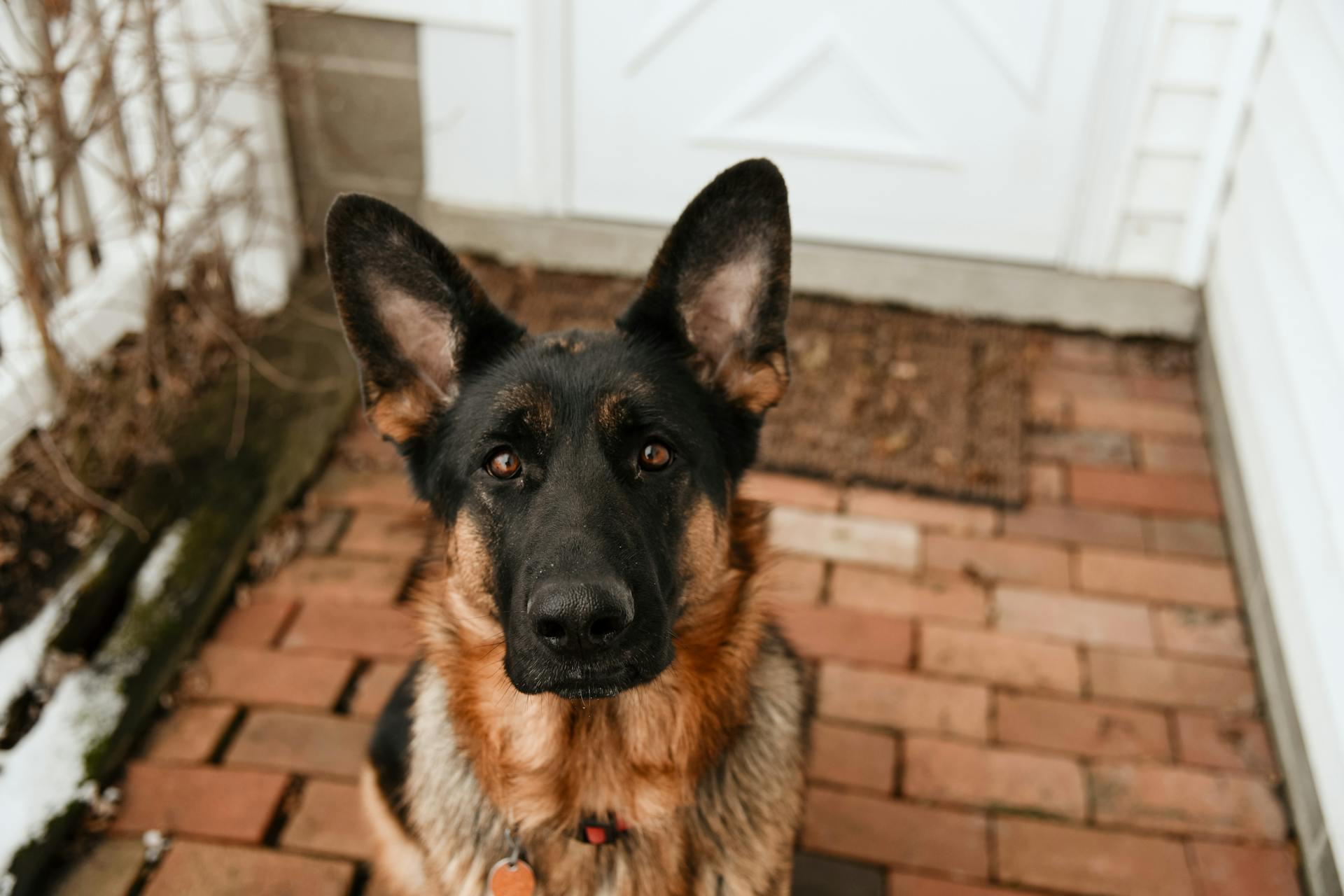
Breeding German Shepherds requires a significant investment of time, money, and resources. The average cost of breeding a German Shepherd litter can range from $5,000 to $10,000.
German Shepherds are a popular breed due to their intelligence, loyalty, and protective nature. They are highly trainable and often work as police and military dogs.
To ensure the health and well-being of your German Shepherd breeding program, it's essential to have a clear understanding of their genetic history. This includes knowing the lineage of your breeding dogs and any potential genetic disorders they may carry.
German Shepherds typically have a litter size of 8-10 puppies, with some litters being as small as 5 or as large as 12.
If this caught your attention, see: Breeding Yorkshire Terriers
History of German Shepherds
Captain Max von Stephanitz is the founder of the German Shepherd breed, and he started standardizing it in 1889. He was at a dog show in Karlsruhe, Germany, where he saw a dog that would change everything.
That dog, Hektor Linksrhein, was a medium-sized wolflike dog with a coat of yellow and gray. It was a working sheepherder that required minimal training to become proficient.
Von Stephanitz was impressed by Hektor's primal canine type, supple power, endurance, steadiness, and intelligence. He renamed the dog Horand von Grafrath and made him the first registered German Shepherd Dog.
Captain Max von Stephanitz Founds the German Shepherd
Captain Max von Stephanitz was a key figure in the development of the German Shepherd breed. He began the standardization of the breed in 1889.
A dog show in Karlsruhe, western Germany, is where it all started for von Stephanitz. He saw a dog that caught his attention, a medium-sized yellow-and-gray wolflike dog.
This dog, Hektor Linksrhein, was a working sheepherder that required no training other than direction and finish to become proficient at the task. He was a primal canine type, supple and powerful, and possessed endurance, steadiness, and intelligence.
Von Stephanitz purchased Hektor Linksrhein and renamed him Horand von Grafrath, making him the first registered German Shepherd Dog.
First Exhibited in America
The first German Shepherd Dog to be exhibited in America was Mira von Offingen, who made her debut in 1907. She was imported by Otto Gross and shown by H. Dalrymple in the open class at Newcastle and Philadelphia.
Mira von Offingen's exhibition marked a significant milestone in the history of German Shepherds in America.
Breed Characteristics
German Shepherds are a medium to large-sized breed, typically weighing between 75-95 pounds and standing between 24-26 inches tall at the shoulder.
They are a highly intelligent breed, ranking 3rd in Stanley Coren's book "The Intelligence of Dogs" for working and obedience intelligence.
Their high energy levels require regular exercise, ideally at least 30 minutes per day, to keep them physically and mentally stimulated.
German Shepherds are naturally protective of their family and territory, but with proper socialization, they can be friendly and outgoing with strangers.
Their thick double coat sheds heavily, especially during shedding season, and requires regular brushing to prevent matting and tangling.
Overall, German Shepherds are a popular breed for families and working roles due to their loyalty, intelligence, and high energy levels.
Traits
German Shepherds are a medium to large breed, weighing between 75 and 95 pounds and standing between 22 to 26 inches tall at the shoulders.
Their muscular bodies are lean and agile, making them well-suited for active lifestyles. Their iconic traits include an extended muzzle and tall, erect ears.
German Shepherds come in a variety of colors, including black, brown, and different color combinations like black and tan, black and silver, and red and black. A distinctive black mask marking is common on their faces, and many have black backs.
Their coats can be short-haired, medium-haired, or long-haired, with long-haired GSDs requiring more grooming maintenance.
Check this out: White Long Haired German Shepherd Dogs
Size
German Shepherds are a medium to large breed, characterized by a strong and robust build. They typically stand between 22 and 26 inches tall at the shoulders.
Their weight range is also impressive, usually falling between 50 to 90 pounds. Males tend to be heavier than females, which is reflected in their substantial and muscular appearance.
A well-proportioned body structure, with a level back, strong hindquarters, and deep chest, emphasizes their agility and strength. This is a result of their historical role as herding and working dogs.
Here are the specific size ranges for German Shepherds:
Their size is an important aspect of their multifaceted nature, contributing to their role as capable guardians and protectors.
Coat Color and Grooming
German Shepherds come in a wide range of coat colors and patterns, including black, black and tan, black and silver, and red and black.
Their iconic black mask marking on their faces is a distinctive trait of the breed. Most German Shepherds have a black back, but not all of them.
The breed can be short-haired, medium-haired, or long-haired, with long-haired GSDs requiring more grooming maintenance. German Shepherds have a double coat with a harsh and dense outer coat and a softer undercoat.
They shed heavily, especially during certain periods of the year, and require regular brushing to control the amount of loose hair. A quick brushing two or three times a week is usually sufficient.
Expand your knowledge: German Shepherds Long Hair
However, during heavy shedding periods, more frequent brushing may be necessary to keep the coat under control. German Shepherds need a bath occasionally, but it's essential to trim or dremel their nails every month.
Their coat serves as a natural shield against rain, snow, and prevents the accumulation of burrs and dirt. The outer layer features dense, straight hair that lies close to the body.
Regular brushing, ideally two to three times a week, can help manage the shedding situation by capturing more hair in the brush than on furnishings. A reliable vacuum cleaner also proves advantageous.
Bathing should be administered judiciously to avoid stripping the coat's essential oils, which sustain its health.
Take a look at this: Do German Shepherds Have Hair or Fur
Responsibility and Care
As a responsible dog breeder, you have a significant impact on the development of your German Shepherd puppies. You form the foundation for their development during the first weeks of life, and your imprinting sets the stage for the human-dog relationship.
Dog breeders have a great responsibility, and to recognize this, the SV awards a Breeder Badge to members who demonstrate proper conduct and maintain clean dog and kennel facilities.
To ensure the well-being of your German Shepherd, you need to provide them with daily exercise to release their excess energy. This is crucial, as extended periods of solitude without physical exertion can lead to issues like boredom and undesirable behaviors.
A surplus of energy is a natural trait in German Shepherds, which means they require both physical engagement, such as jogging or playtime at a dog park, and mental stimulation, like participation in agility or obedience competitions.
Care
German Shepherds are engineered for activity, so they need daily exercise to release their surplus of energy.
Boredom and inactivity can lead to undesirable behaviors like digging and excessive barking.
Regular physical engagement, such as jogging or playing at a dog park, is essential.
Mental stimulation through activities like agility or obedience competitions is also necessary.
Teaching the "Quiet" command is a good idea to address excessive barking.
German Shepherds have a penchant for chewing, so it's crucial to provide safe chew toys and bones.
Their jaw strength is formidable, so it's essential to prevent them from chewing on hazardous materials.
Consistent training and rewards can produce excellent results, especially in a breed as intelligent as the German Shepherd.
Socializing and training should start early, ideally when your puppy is about ten weeks old.
Regular exercise is vital to prevent frustration and the development of negative behaviors.
Participating in activities like tracking, agility, and herding provides great physical exercise and mental stimulation.
Responsibility
Dog breeders have a great responsibility that forms the foundation for a dog's development during the first weeks of life.
Their imprinting on the breeder sets the basis for the subsequent human-dog relationship.
SV members who earn special merits in breeding German Shepherds are awarded a Breeder Badge in bronze, silver or gold.
These badges are only awarded to members who have earned merits for breeding German Shepherds.
Each dog suitable for assessment is assessed only once, following a strict point system.
Only those breeders who demonstrate proper conduct in all aspects and maintain flawless, clean dog and kennel maintenance will receive such a coveted badge.
Grooming
German Shepherds are relatively easy to groom, requiring a quick brushing two or three times a week to remove loose hairs.
You'll need to brush more frequently during periods of heavy shedding, which can be quite profuse.
A bath every now and then is fine, but don't forget to trim or dremel their nails every month to keep them clean and healthy.
Regular brushing can help manage the amount of shed hair, and it's also a great way to bond with your German Shepherd.
A reliable vacuum cleaner is your best friend when it comes to dealing with the breed's consistent shedding throughout the year.
German Shepherds tend to maintain a fairly clean and odor-free disposition, but monthly nail trims and weekly ear checks are still essential for their hygiene.
Nutrition

German Shepherds need a balanced diet to stay healthy, and the amount of food they require can vary depending on their age and size.
Generally, a German Shepherd needs up to two cups of dog food twice a day, but it's best to consult with a veterinarian to determine the right amount for your dog.
Feeding table scraps of human food can cause stomach upset in dogs, especially if it's high in fat.
Fresh water should always be available for your German Shepherd.
Other Pets
Living with other pets can be a great experience for German Shepherds. They can harmoniously coexist with other dogs and pets, provided they receive proper guidance from an early age.
Introducing an adult German Shepherd into a household with existing pets might pose challenges. Their reserved demeanor translates into a cautious approach with unfamiliar pets.
With patience and proper training, adult German Shepherds can learn to socialize with other dogs and cats. Enlisting the aid of a professional trainer or seeking guidance from the rescue organization can prove beneficial in such cases.
German Shepherds are generally reliable, but their size means they may accidentally bump into smaller pets. This is especially true with toddlers or small children, so it's essential to supervise interactions closely.
A well-trained German Shepherd can make an excellent companion for kids, but it's crucial to expose them to children during their puppyhood. This helps them develop gentleness and protective instincts towards the youngsters within their family.
Breeding and Pedigree
A pedigree is not the same as a genealogical tree, it's a document that verifies a dog's purebred status. The breed certificate of authenticity, issued by a recognized association, is the most important document a buyer of a German Shepherd must have.
The pedigree, issued by the SV, records the 30 direct ancestors of the animal and lists their performance records, coat types, colors, and other information. This document is essential for responsible breeders to plan future breeding.
To guarantee pedigree records for breeding animals, the SV introduced DNA analytical methods in 1999. This means that breeders must have their dogs' DNA analyzed to ensure the accuracy of the pedigree. The results are stored in a genetic database and are available for subsequent pedigree evaluations initiated by the SV.
Recommended read: Types of Bull Terrier
You can register your German Shepherd in the SV annex register if you don't have a recognized pedigree or if your pedigree is not recognized by the VDH or FCI. This allows you to participate in VDH exhibitions and tests, and SV breeding shows, but you'll need SV membership for the latter.
The Club of America Founded 1913
The German Shepherd Dog Club of America was formed in 1913 by Benjamin Throop and Anne Tracy, with 26 charter members.
In its early years, the club hosted its first specialty show at Greenwich, Connecticut in 1915.
The club's name was changed to the Shepherd Dog Club of America in 1917, following America's entry into World War I.
Breed Data
The German Shepherd breed is a popular and iconic one. They originated in Germany and are classified as a herding breed.
Their physical characteristics are quite impressive. German Shepherds typically stand between 22-26 inches tall and weigh between 75-95 pounds.
Here's a breakdown of their vital statistics:
Their life expectancy is relatively short, ranging from 7-10 years.
Pedigrees vs. Genealogical Trees
Pedigrees are not the same as genealogical trees. A pedigree is an official extract of the stud book, recording the 30 direct ancestors of the dog, while a genealogical tree leads back to the origin of the breed – back to the progenitor.
The pedigree contains information about the dog's breeding license report, including its virtues and disadvantages, and the ownership status is also registered in the pedigree. Every seller of a German Shepherd must hand over the pedigree, registering and confirming the new owner in the pedigree when selling the dog.
In contrast, a breed certificate of authenticity leads back to the generation of the great-great-grandparents of the dog and gives information about their qualities, including performance records, colors of the siblings, coat types, colors, and results of training, exhibitions, and licensing events.
Here's a comparison of the two:
The SV offers an annex register for dogs without a pedigree or with pedigrees not recognized by the VDH or the FCI, which allows them to participate in VDH exhibitions and tests, SV breeding shows, and breeding with long coats and undercoats.
Take a look at this: Bull Terrier before Breeding
Licensing
Licensing is a crucial step in the breeding process of German Shepherds.
The breed licensing is reserved exclusively to animals registered in the stud book of the German Shepherd Association (SV) e. V.
To be eligible, animals must be healthy and identifiable through their tattoo/microchip number.
Sick animals and those that can't be identified are not admitted to the initial licensing.
A breed licensing document is a rating awarded exclusively by the licensing inspectors who have performed special services as breeding judges for the SV.
Around 3,000 to 4,000 German Shepherds take this test every year.
The character test is the first step in the licensing process, where the dog demonstrates its unbiased, well-balanced, self-confident, and good-natured traits.
The dog is exposed to different stimuli situations, and its mastering of these situations shows its characteristic traits.
The dog must be controlled by its handler at all times during the test.
Where to Get
If you're looking to get a dog with a purebred pedigree, you can check with reputable breeders who are members of kennel clubs such as the American Kennel Club (AKC).
You can also try contacting breed clubs that are associated with the breed you're interested in. These clubs often have a list of reputable breeders who are knowledgeable about the breed and can provide you with a dog that meets the breed standard.
Some breeders may also offer puppies that are registered with a kennel club, which can give you an idea of the dog's ancestry and potential traits.
Breeders who are registered with a kennel club often have a code of ethics that they must follow, which can ensure that the dogs are treated with care and respect.
Related reading: Dutch Shepherd Breeders Usa
Health
German Shepherds are generally a healthy breed, but like all breeds, they can be prone to certain health issues. Hip dysplasia is a common concern, where the femur doesn't fit properly into the hip joint's pelvic socket.
Elbow dysplasia is another hereditary condition that affects the elbow joint, causing joint instability and painful lameness. This condition is often found in large breeds.
Gastric dilatation-volvulus, also known as bloat, is a life-threatening situation that can occur in deep-chested dogs. It's essential to recognize the symptoms, such as abdominal distension, excessive salivation, and restlessness, to prevent shock and potential fatality.
Degenerative myelopathy is a progressive spinal cord disease that affects the hind legs' communication with the brain, leading to coordination issues and eventually an inability to walk. Treatment options are limited, but vitamin deficiencies may be addressed through supplementation.
Exocrine pancreatic insufficiency is a genetic disorder that impairs digestive enzyme production, causing symptoms like gas, appetite loss, and weight reduction. Diagnosis is straightforward through a blood test, and treatment involves adding pancreatic enzymes to the dog's diet.
Allergies are also a concern for German Shepherds, which can manifest as contact or food sensitivities. Indicators may include persistent scratching, paw licking, and facial rubbing.
Here are some common health issues affecting German Shepherds:
- Elbow dysplasia
- Hip dysplasia
- Gastric dilatation-volvulus (bloat)
- Degenerative myelopathy
- Exocrine pancreatic insufficiency
- Allergies
Genetic predisposition plays a significant role in the development of these diseases, but influences from feeding and rearing are also important factors. Medical treatments can have severe side effects, so it's essential to work with breeders, veterinarians, and the German Shepherd Association to reduce the incidence of these conditions.
Popularity and Organizations
The popularity of German Shepherds took off after World War I, thanks in part to the breed's impressive performance as war dogs and the success of movies like Rin-Tin-Tin and Strongheart.
The breed's popularity led to a surge in demand, which unfortunately resulted in many poor-quality "German police dogs" being mass-produced in puppy factories. However, serious breeders like Mrs. Harrison Eustis of Fortunate Fields Kennels in Switzerland continued to produce high-quality dogs through scientific research and careful breeding.
To find a reputable breeder, it's essential to look for someone who prioritizes breeding healthy, well-socialized puppies and provides lifetime support. Unfortunately, backyard breeders often prioritize profits over the welfare of their dogs.
Here are some reputable organizations that promote responsible breeding and ownership:
- German Shepherd Dog Club of America
- World Union of German Shepherd Associations
These organizations serve as a hub for enthusiasts, breeders, and owners, fostering a sense of camaraderie and providing a platform for sharing knowledge.
Popularity
The popularity of German Shepherds was a wild ride after World War I. Tales of their heroism in the war effort sparked a surge in demand, with some U.S. soldiers even bringing them back home.

Rin-Tin-Tin and Strongheart's movies further fueled the craze, making the breed a household name. Puppy factories sprouted up to meet the demand, but they churned out poor-quality dogs that ultimately led to a downturn in popularity.
Serious breeders like Mrs. Harrison Eustis continued to produce high-quality dogs through scientific research and careful breeding. Her dogs were even used as guide dogs for the blind at the Seeing Eye in Morristown, New Jersey.
In 1922, Germany introduced a system of regular breed surveys to ensure the quality of their dogs. This system never caught on in America, but it shows that even back then, people were concerned about the welfare of their dogs.
Organizations
If you're considering bringing a German Shepherd into your life, it's essential to know about the breed organizations that support and promote this amazing breed.
Reputable dog breeders are often affiliated with these organizations, which provide a framework for responsible breeding practices.

The German Shepherd Dog Breed Organizations play a crucial role in ensuring the health and well-being of the breed.
They do this by promoting responsible ownership through training and education, as well as advocating for the breed's integrity.
Some notable organizations include the German Shepherd Dog Club of America and the World Union of German Shepherd Associations.
These clubs serve as a hub for enthusiasts, breeders, and owners, fostering a sense of camaraderie and a platform for sharing knowledge.
Here are some of the key organizations that support the German Shepherd breed:
- German Shepherd Dog Club of America
- World Union of German Shepherd Associations
Frequently Asked Questions
How many puppies does a German Shepherd have the first time?
The average number of puppies in a German Shepherd's first litter is 8, but it can range from 1 to 15. Understanding the factors that influence litter size can help you better prepare for your new furry family members.
How many times a year can you breed a German Shepherd?
German Shepherds can be bred twice a year, but the decision to breed depends on the breeder's selection of a suitable stud dog
Featured Images: pexels.com


